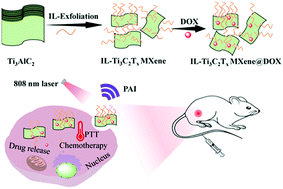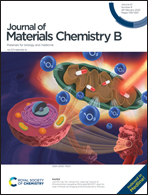Ionic liquid exfoliated Ti3C2Tx MXene nanosheets for photoacoustic imaging and synergistic photothermal/chemotherapy of cancer†
Abstract
Ti3C2Tx MXene is a new type of two-dimensional material with good biocompatibility and a good photothermal effect, and shows great potential in cancer treatment. In this study, few-layer ionic liquid (IL)-Ti3C2Tx MXene nanosheets were synthesized using IL stripping technology, which have high chemical stability, and allow photoacoustic imaging and synergistic photothermal/chemotherapy of cancer. Under 808 nm laser irradiation, the nanosheets have strong absorption in the near-infrared region, and high photothermal conversion efficiency (∼63.91%). Using DOX as a model drug, the IL-Ti3C2Tx MXene@DOX nanosheets exhibited high drug loading capacity and pH-/photosensitivity, which will further promote the drug release of the nanosheets in an acidic tumor microenvironment and under 808 nm laser irradiation. In vitro and in vivo experiments showed that IL-Ti3C2Tx MXene@DOX has good biological safety, allows remarkable photoacoustic imaging, and can effectively kill cancer cells with synergistic photothermal/chemotherapy. Therefore, IL-Ti3C2Tx MXene nanosheets are expected to provide powerful and useful two-dimensional nanoplatforms for various biomedical applications.

- This article is part of the themed collections: 2022 Journal of Materials Chemistry B Most Popular Articles and 2023 Journal of Materials Chemistry B Lunar New Year


 Please wait while we load your content...
Please wait while we load your content...